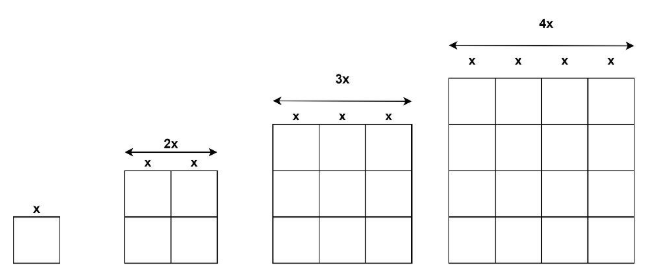
Which numbers can be shown as squares?
Answer
601.5k+ views
Hint: Try to find the square of natural numbers. Hence from them obtain the square numbers. Try to give alternate explanations other than the arithmetic one.
Complete Step-by-Step solution:
Natural numbers are the positive numbers starting from one.
Squaring a number means multiplying the number by itself.
When you multiply a natural number of times itself, the resulting product is called a square number, or a perfect square or simply "a square."
So, 1, 4, 9, 16, 25, 36, 49, 64, 81, 100, 121, 144, and so on, are all square numbers.
As,
$
1 \times 1 = 1 \\
2 \times 2 = 4 \\
3 \times 3 = 9 \\
4 \times 4 = 16 \\
5 \times 5 = 25 \\
$
It could also be thought of in a geometrical way.
Let 1 represent a square of side x.
Individually a single square is itself a square of side x.
If we combine 4 such squares, it results in a bigger square of side 2x. Hence, 4 is also a square number.
Similarly, by combining 9 such squares of side x, a bigger square of side 3x is formed, which implies 9 is also a square number.

Hence this trend can be continued and we can get the square numbers as:
1, 4, 9, 16, 25, 36, 49, 64, 81, 100, 121, 144 and so on.
Hence the above numbers could be shown as the square numbers.
Note: The above square numbers which result from natural numbers are more specifically the positive integral numbers. Integers are the numbers having no decimal part or fractional part. Square numbers are also known as perfect squares.
Complete Step-by-Step solution:
Natural numbers are the positive numbers starting from one.
Squaring a number means multiplying the number by itself.
When you multiply a natural number of times itself, the resulting product is called a square number, or a perfect square or simply "a square."
So, 1, 4, 9, 16, 25, 36, 49, 64, 81, 100, 121, 144, and so on, are all square numbers.
As,
$
1 \times 1 = 1 \\
2 \times 2 = 4 \\
3 \times 3 = 9 \\
4 \times 4 = 16 \\
5 \times 5 = 25 \\
$
It could also be thought of in a geometrical way.
Let 1 represent a square of side x.
Individually a single square is itself a square of side x.
If we combine 4 such squares, it results in a bigger square of side 2x. Hence, 4 is also a square number.
Similarly, by combining 9 such squares of side x, a bigger square of side 3x is formed, which implies 9 is also a square number.

Hence this trend can be continued and we can get the square numbers as:
1, 4, 9, 16, 25, 36, 49, 64, 81, 100, 121, 144 and so on.
Hence the above numbers could be shown as the square numbers.
Note: The above square numbers which result from natural numbers are more specifically the positive integral numbers. Integers are the numbers having no decimal part or fractional part. Square numbers are also known as perfect squares.
Recently Updated Pages
Master Class 10 General Knowledge: Engaging Questions & Answers for Success

Master Class 10 Computer Science: Engaging Questions & Answers for Success

Master Class 10 English: Engaging Questions & Answers for Success

Master Class 10 Social Science: Engaging Questions & Answers for Success

Master Class 10 Maths: Engaging Questions & Answers for Success

Master Class 10 Science: Engaging Questions & Answers for Success

Trending doubts
The shortest day of the year in India

Why is there a time difference of about 5 hours between class 10 social science CBSE

Write a letter to the principal requesting him to grant class 10 english CBSE

What is the median of the first 10 natural numbers class 10 maths CBSE

The Equation xxx + 2 is Satisfied when x is Equal to Class 10 Maths

State and prove converse of BPT Basic Proportionality class 10 maths CBSE




